#Presentation Visual Enhancement
Text
Selecting the Right Tools for Effective Presentations
Selecting appropriate tools for presentations is a critical aspect of delivering an impactful message to an audience. A presenter should carefully assess the purpose and objectives of their presentation to determine the most effective tools for conveying information. This could range from traditional slide decks to interactive multimedia presentations, depending on the nature of the content being presented. It is also crucial to take into account the audience's technological proficiency when choosing the tools to ensure seamless communication and engagement.
Moreover, rehearsing and becoming familiar with the selected tools is imperative for a polished and professional delivery that resonates with the audience, making a lasting impression.
By meticulously selecting the right tools, presenters can elevate their presentations and create a memorable experience for their audience. The choice of tools plays a significant role in how information is communicated and perceived by the viewers.
It is essential to strike a balance between technological sophistication and user-friendliness to ensure that the tools enhance rather than distract from the message being conveyed.
A well-prepared presenter who has mastered their tools can captivate their audience, foster engagement, and effectively convey their message with clarity and impact.

Visual Sculptors Designs – Aligned to Client Branding Guidelines.
To ensure that presentations are in line with a management consulting company's branding and messaging, we adopt various important strategies: After signing an agreement with a firm, we have calls to understand past projects and brand guidelines. We then create a detailed style sheet for approval, usually finalizing after 1-2 iterations. For the initial 10-15 deliveries, the agency prioritizes delivering high quality work with multiple quality checks. This includes ensuring brand consistency in aspects like color scheme, choosing appropriate chart types, and formatting elements. Graphic design process helps familiarize the agency team with the client's brand.
#Consulting Presentation#Business Presentation#Graphic Design#Management Consulting Presentation#Pitch Deck Design#Corporate Presentation#Executive Presentation#C-Level Presentation#Business Report Design#Mc-Kinsey Style Presentation#Top-Level Consulting Presentation Designs#Presentation Visual Enhancement
2 notes
·
View notes
Text
youtube
#ntelligent Lookup#Database Views#Data Retrieval#Data Presentation#Database Optimization#Data Analysis#Database Relationships#Data Visualization#Database Tutorial#Query Optimization#Data Enhancement#Database Management#SQL Views#Data Integration#Related Tables#Youtube
0 notes
Photo






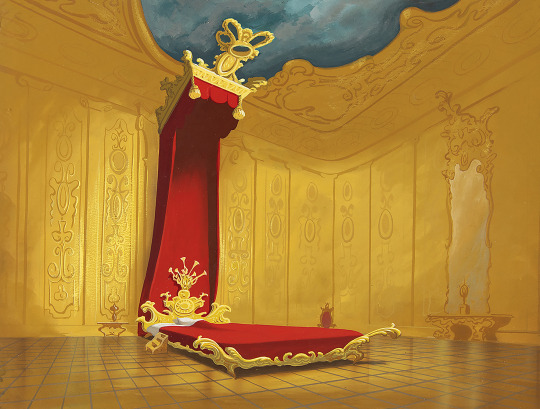

Background art for Cinderella (1950) from the Walt Disney Animation Research Library
“Cinderella's background paintings remind me of grand stage sets for a Viennese Operetta by Johann Strauss. Everything is exaggerated in order to enhance a dreamlike, sentimental mood. The movie was made on a shoestring budget, yet its visual presentation is opulent and luscious. You combine that with rich storytelling, and you get a classic for the ages.” - Andreas Deja
#Disney#cinderella#background art#disney concept art#backgrounds#art#artwork#illustration#disney animation#animation art#production art#concept art#animation#disney art#vintage disney
5K notes
·
View notes
Text
Types of meditation
1. Mindfulness meditation: Focus on your breath or a specific sensation, bringing your attention to the present moment.
2. Loving-kindness meditation: Cultivate feelings of love and compassion towards yourself and others.
3. Transcendental Meditation: Repeat a mantra to achieve a state of relaxed awareness.
4. Body scan meditation: Direct attention to different parts of your body, releasing tension and promoting relaxation.
5. Zen meditation (Zazen): Sit in a specific posture, focus on your breath, and observe thoughts without attachment.
6. Guided meditation: Follow a recorded or live guide's instructions for visualization and relaxation.
7. Vipassana meditation: Develop insight by observing bodily sensations and thoughts with non-reactive awareness.
8. Yoga nidra: A state of conscious relaxation achieved through guided meditation while lying down.
9. Chakra meditation: Focus on energy centers in the body, visualizing and balancing them.
10. Mantra meditation: Repeat a word, phrase, or sound to quiet the mind and enhance concentration.
#mindfulness#meditation#witchblr#witchcore#witchcraft#witchlife#white witch#beginner witch#witch tips#grimoire#spirituality#meditation types#meditation tips#affirmations
1K notes
·
View notes
Text
·˚ ༘ practicing self-care when you're tired*ೃ༄
rest and recharge: honor your body's signals and give yourself permission to rest. curl up with a cozy blanket, sip on a warm cup of tea, and allow yourself to simply be. even a short nap or some quiet time can work wonders for replenishing your energy reserves.
nourish your body: opt for nourishing foods that provide sustained energy without causing spikes and crashes. focus on whole, nutrient-rich foods like fruits, vegetables, whole grains, and lean proteins. stay hydrated by drinking plenty of water throughout the day.
gentle movement: engage in gentle movement practices that help to invigorate your body and uplift your spirits without draining your energy. try a leisurely walk in nature, a restorative yoga class, or some gentle stretching to release tension and boost circulation.
pamper yourself: indulge in some self-care rituals that make you feel pampered and cherished. take a warm bath with epsom salts and essential oils, treat yourself to a soothing massage or facial, or simply curl up with a good book and lose yourself in its pages.
connect with loved ones: reach out to friends, family, or loved ones for support and connection. sometimes, a heartfelt conversation or a listening ear can provide the comfort and encouragement you need to navigate challenging times.
set realistic expectations: be kind to yourself and adjust your expectations to align with your current energy levels. prioritize essential tasks and let go of non-urgent commitments or obligations until you're feeling more energized.
practice mindfulness: cultivate mindfulness by bringing your awareness to the present moment with kindness and curiosity. engage in activities like deep breathing, meditation, or visualization to calm your mind, reduce stress, and enhance overall well-being.
remember, self-care is not selfish—it's essential for maintaining your health, happiness, and vitality, especially during times of low energy. listen to your body, honor your needs, and trust that you're doing the best you can. you deserve love, care, and compassion, always.
#self care#self improvement#self love#self reflection#self worth#that girl#it girl#clean girl#pastel dreamer✨
603 notes
·
View notes
Text
secrets of the siren [ 1 ]



1. magnetize with your eyes. hold eye contact with others. not in a competitive way, but in a enticing way. (like a game).
2. look appealing. in order to play the role, you must look the part. your visual presentation is the most powerful and enchanting tool you possess. you can use it to compel literally anyone. wear fitting clothes that compliment your body and show your assets. wear flattering makeup to enhance your features. make your movements graceful and unhurried.
3. master your voice. it is important to keep your voice calm. speak slowly and clearly. this creates a mesmerizing effect, where your target is hanging onto your every word. never rush, mumble or hesitate. and always speak to peoples emotions instead of their rationality. say things that make them feel good. (people don’t remember what you say, they remember they way you made them feel).
4. embrace your sensual side. society teaches you to be ashamed of your sensual and attractive nature (especially women), but every species on this planet has carnal needs, including you. release the shame surrounding your sensuality. indulge in your desires. learn how to arouse (yourself and others). attract through with your sex appeal and radiate an aura of pleasure.
5. keep the mystery. never reveal more than you need to. remember, this is a game of chess not checkers, so always have a game plan. be cool and controlled (this displays confidence), instead of erratic and impulsive (this displays insecurity). take your time before making a decision to let information soak in.

[ part 2 ]
#siren#sirencore#dark feminine energy#devilcore#succulentsiren#dark feminine aesthetic#it girl#divine feminine#coquette#sayhoneysiren#seduction#femme fatale#dark femme#dark goddess#dark feminine#femininity#feminine#witch#witchcraft#angelina jolie#persuasion#cherry#pretty#affirmations#manifest#aura#vibe#high vibration#high value woman#high value
1K notes
·
View notes
Text
A Beginner's Guide: Exploring the Basics of Witchcraft
Are you intrigued by the mystical world of witchcraft and eager to begin your magical journey? Whether you're drawn to the art of spellcasting, divination, or connecting with nature's energies, the basics of witchcraft provide a solid foundation for your exploration. Here's a beginner's guide to help you embark on this enchanting path:

1. Understanding Witchcraft:
Witchcraft is a spiritual practice that encompasses a diverse range of traditions, each with its own beliefs and practices. It is fundamentally about harnessing personal power, connecting with nature, and creating positive change.
2. Embracing Your Path:
Witchcraft is highly personal, and there is no one-size-fits-all approach. Explore different traditions, read books, and listen to your intuition to discover what resonates with you. Your journey is uniquely yours.
3. The Power of Intention:
At the heart of witchcraft is intention. Your thoughts and feelings shape the energy you put into the universe. Clarify your goals, visualize your desires, and set clear intentions for your magical work.
4. Working with Energy:
We believe in the existence of energy that flows through everything. Learn to sense and manipulate this energy through practices like grounding, centering, and visualization.
5. Tools of the Craft:
While not mandatory, many witches use tools such as candles, crystals, herbs, and tarot cards to amplify their intentions. Familiarize yourself with these tools and choose the ones that resonate with you. Intention is your most powerful tool.
6. Moon Phases and Timing:
The phases of the moon play a significant role in witchcraft. Learn about the energy associated with each phase (new moon for beginnings, full moon for culmination) and align your magical workings accordingly.
7. Spellcasting Basics:
Spellcasting involves directing energy toward a specific goal. Start with simple spells, focusing on your intentions. Remember, the more aligned your actions are with your intention, the more powerful the spell.
8. Meditation and Visualization:
Cultivate a regular meditation practice to quiet the mind and enhance your ability to visualize. Visualization is a potent tool in spellcasting and energy work. This is so important for overall focus and mental clarity.
9. Protection and Grounding:
Before delving into magical practices, establish protection and grounding techniques. This ensures you are anchored in the present and shielded from unwanted energies.
10. Building an Altar:
An altar serves as a sacred space for your magical work. Personalize it with items that hold significance for you—crystals, candles, symbols, and representations of the elements.
11. Respect for Nature:
Witches often have a deep connection with nature. Spend time outdoors, observe the changing seasons, and incorporate natural elements into your practice.
12. Research and Learning:
Knowledge is a cornerstone of witchcraft. Read books, join online communities, and attend local events to expand your understanding of different traditions, rituals, and practices.
13. Ethics and Responsibility:
Ethical considerations are crucial in witchcraft. Respect the free will of others and act with responsibility and integrity.
14. Journaling Your Journey:
Keep a magical journal to document your experiences, spells, and reflections. This becomes a valuable resource for tracking your progress and understanding patterns in your magical work.
15. Embrace Your Unique Path:
Witchcraft is an ever-evolving journey. Embrace your uniqueness, trust your intuition, and allow your path to unfold organically. There are no rigid rules—only the ones you choose to follow on your enchanted journey.
Remember, the essence of witchcraft lies in the exploration of the self, the connection with the natural world, and the pursuit of personal growth. May your journey into witchcraft be filled with wonder, discovery, and the magic of self-discovery. 🔮🌙✨
My messages are open for questions and ideas! Happy Witching!
#queue the magick#witchcraft#witch#witchblr#magickkate#kitchen witch#sigils#protection magic#witchcore
187 notes
·
View notes
Text
A swimming lesson
It was another typical day at school, and as usual, I found myself in the crosshairs of Mr. Coachman's disdain. My name is Tristan, and I am what one might call an "unsporty" student. Thin, nerdy, and full of useless facts, I was the kid who always got picked last in gym class. Mr Coachman, a former athlete turned sport and philosophy teacher, had no patience for my know-it-all attitude. He believed that my incessant need to correct everyone was hindering the class and, quite frankly, his sanity. One day, Mr. Coachman approached me after yet another unnecessary correction during PE. He offered me a chance to improve my abysmal grades in sports by taking extra swimming lessons with him. Reluctantly, I agreed, desperate to boost my overall GPA. At our first swimming session, Mr. Coachman handed me a peculiar-looking swimming cap. He claimed it would allow me to hear and see his instructions directly in my head. I thought he was out of his mind, but upon putting on the cap, I realized it actually worked. It was a surreal experience, feeling Mr. Coachman's voice and visual cues echoing in my mind as I swam. The instructions were crystal clear, making it easier to perfect my stroke and improve my technique in record time. Weeks later, Mr. Coachman, noticing my progress, approached me with a new pair of swim goggles. He said they would help me focus better in the pool. Skeptical yet willing to try anything, I put them on and dove in. As soon as the water enveloped me, I felt a heightened sense of concentration. The outside world disappeared, and all that mattered was the water beneath me. Mr. Coachman's voice became a distant echo, guiding me through each stroke and turn. It was as if the goggles had transformed me into a single-minded swimming machine.

Mr Coachman observed my newfound dedication and satisfaction. I was exhausted from the intense swim training, which left me with no energy to display my usual know-it-all tendencies in class.

Several weeks later, Mr Coachman's next request gave me pause. He presented me with a slim blue Speedo and promised that it would enhance my speed in the water. There was just one catch—I had to shave off all my body hair. He argued that professional swimmers did it all the time for better speed and reduced resistance. I protested vehemently. "Shave off all my body hair? Are you out of your mind?" I exclaimed, my voice filled with disbelief. Mr Coachman, with a grin on his face, replied, "Of course not, Tristan! It's a small sacrifice in pursuit of greatness. Trust me, you'll thank me later." I crossed my arms stubbornly, determined to resist this outrageous demand. "Absolutely not! I'll wear the Speedo, but I draw the line at shaving my body hair. It's like asking a caterpillar to give up its fuzzy coat!" Mr Coachman's smile didn't falter, and he simply said, "Suit yourself, Tristan. But just remember, the pros do it for a reason." His words lingered in the air as an internal struggle waged within me. The temptation to conform and become the ultimate swimmer clashed with my natural inclination to rebel against such absurdity. In the end, though, curiosity won over. I figured, if I could endure the grueling training and wear these magical swimming items, what harm could a little body hair removal do? With a hesitant sigh, I finally agreed to Mr. Coachman's request. Trudging to the bathroom, I grabbed a razor, examining its gleaming blade with trepidation. As I stood before the mirror, thoughts of caterpillars and metamorphosis floated through my mind. I wondered if shaving off my body hair would truly transform me into a swimming powerhouse. With each stroke of the razor, I felt a mix of excitement and unease. Whiskers and hairs fell, leaving behind smooth, hairless skin. Trapped in my thoughts, I couldn't help but wonder what my friends would say or how they would react when they discovered my newfound aquatic obsession and hairless body. Finally, once all the hair was gone, I took a long look at my smooth reflection. It was a strange sight, almost otherworldly. I felt a mix of vulnerability and exhilaration, like a sea creature shedding its scales and emerging anew. Standing tall in my hairless glory, I slipped into the slim blue Speedo. Ready or not, I was about to dive into the next chapter of this bizarre journey, hoping that my shaved body would indeed prove to be a worthwhile sacrifice in the pursuit of greatness. Emerging from the water for the first time in my stylish Speedo, I had transformed. My physique resembled that of a Greek statue, not an ounce of body fat in sight. I was an athletic swimmer, a force to be reckoned with.

With my old clothes no longer fitting, Mr. Coachman outfitted me with a tight beige chino and a light blue shirt.
As I squeezed myself into the outfit, I couldn't help but complain about looking like a preppy dork. However, Mr. Coachman assured me that it was all about how I wore the clothes. Skillfully, he rolled up the sleeves of my shirt, unbuttoned the top buttons, and stood back to appraise his handiwork. "Aren't you a handsome devil?" he remarked with a satisfied grin.

Surprisingly, I found myself thanking him, swallowed by a sense of excitement and self-confidence that I had never experienced before. Something about Mr. Coachman's approval made me feel alive and validated, even if I couldn't pinpoint exactly why I had become so susceptible to his influence. And thus, Mr. Coachman's cunning plan had come to fruition. Those magical swimming accouterments had not only transformed me into a skilled swimmer but also had slowly but surely chipped away at my once-sturdy resistance. When I wore all three items—cap, goggles, and Speedo—I was utterly beholden to his every command, a true embodiment of the "perfect student-athlete" he had envisioned from the onset. Now a member of the swim team, I had gone from a nerdy outcast to a charming and good-looking athlete, the joy of all my teachers. But deep down, I couldn't help but wonder if Mr. Coachman's methods were entirely ethical. Regardless, I was living proof of his success, and the sensation of hearing Mr. Coachman's voice and visualizing his instructions while wearing the cap and goggles had left an indelible mark on my perception of swimming, forever changing the way I experienced the water.
242 notes
·
View notes
Text
youtube
Shin Megami Tensei V: Vengeance - Announce Trailer
youtube
Japanese version
youtube
Extended Cut
youtube
Extended Cut Japanese version
youtube
Special Program Spotlight
Shin Megami Tensei V: Vengeance will launch for PlayStation 5, Xbox Series X|S, PlayStation 4, Xbox One, Nintendo Switch, and PC (Steam, Microsoft Store) on June 21, 2024 worldwide. Pre-orders will open on February 27, 2024.
Shin Megami Tensei V: Vengeance is an enhanced version of Shin Megami Tensei V, which originally launched for Nintendo Switch in November 2021.

Title logo

Key visual
Overview
The latest title in the series, Shin Megami Tensei V: Vengeance allows players to enjoy the story of Shin Megami Tensei V in its entirety, with a new story path, untold in the original. Massively expanded with new areas, demons, and music, Shin Megami Tensei V: Vengeance features more accessible gameplay, an improved battle system, new demon experiences, and greater field exploration.
Pre-orders for the Nintendo Switch family of systems (physical only), PlayStation 5, PlayStation 4, Steam, Xbox Series X|S, Xbox One and PC will begin on February 27, 2024. Details on digital pre-orders for Nintendo Switch will be announced at a later date.
When a grisly murder scene in modern-day Tokyo blocks the protagonist’s walk home, an unplanned detour leaves him buried and unconscious. He finds himself in a wasteland ravaged by apocalypse now called Da’at. Before bloodthirsty demons can claim his life, a savior emerges, and they unite to become a mighty being, neither human nor demon: a Nahobino.
Shin Megami Tensei V: Vengeance delivers a full-fledged RPG that can be enjoyed by existing and new fans. At the start of the game, players will choose between two paths: the story told in Shin Megami Tensei V, the Canon of Creation, or the brand-new Canon of Vengeance. This dramatic new tale of revenge introduces brand-new characters, an enigmatic cohort of demons called the Qadištu, a new dungeon and map to explore. Additionally, the original Shin Megami Tensei V battle system, demon merging and field exploration have been evolved and expanded in this newest entry in the series.
Further details
■ What is Shin Megami Tensei V: Vengeance?
Released in 2021, ATLUS’s renowned RPG Shin Megami Tensei V has sold more than one million copies worldwide.
This highly acclaimed game has evolved in every aspect, including the system and scenario, and will be available on multiple modern platforms!
At the beginning of the story, the player is presented between two routes. The story told in Shin Megami Tensei V, the Canon of Creation, and a brand-new route, Canon of Vengeance, a dramatic tale of revenge by the fallen.
The Canon of Vengeance follows the scenario of SMTV, but changes drastically from the latter half of the game. The outcome will be completely different. Enjoy the two divergent stories to your heart’s content.
The battle system, demon fusion, and field exploration have also evolved in depth with the addition of new elements. We are excited to deliver a full-fledged RPG that can be enjoyed by those who have already played SMTV, as well as those who are playing this series for the first time.
■ Story
Thou shalt be God—.
When a grisly murder scence in modern-day Tokyo blocks our protagonist’s walk home, an unplanned detour leaves him buried and unconscious. He awakens in a New Tokyo, a wasteland ravaged by apocalypse now called Da’at – but before bloodthirsty demons can claim his live, a savior emerges, and the two of them unite to become a mighty being, neither human nor demon: a Nahobino.

Revenge Awaits—.
Demons attack humans and seek to create a world of chaos.
Bethel, an organization that seeks to protect God’s order.
Caught up in the conflict between the two, while exploring Da’at, the protagonist meets and starts traveling with Yoko Hiromine.
Using magic, Yoko and the main character stand together on the front line.
The Qadistu, four female Demons stand in their way. “Found it, the Key of Resurrection…” A member of the Qadistu, Lilith calls protagonist the Key of Resurrection, and herself The Oppressed.
What is their purpose? A tale of revenge by the oppressed begins.
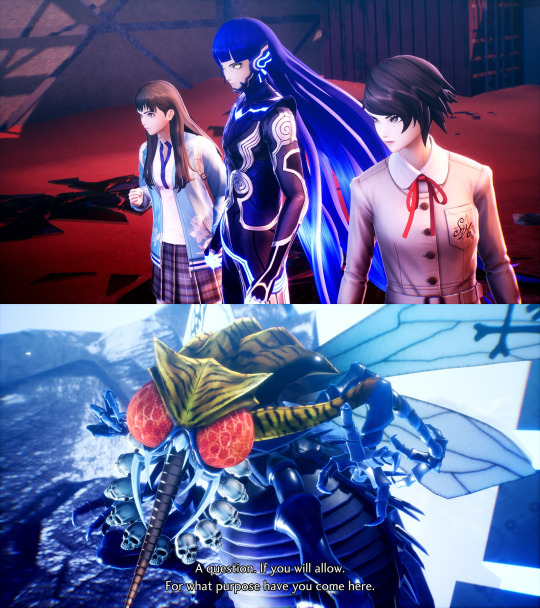
■ The Oppressed: The Qadistu
In the Canon of Vengeance, four female demons appear in front of the protagonist. Another story of creation told by new Demons.

■ Characters
Lilith (voiced by Katelyn Gault in English, Atsuko Tanaka in Japanese)
“I am Lilith of the Qadištu The one to restore the world to what it ought to be.”

A woman who is said to have been Adam’s first wife in the Old Testament. Later left Garden of Eden and turned into a demon.
Leader of the Qadištu. In order to achieve an unidentified goal, she stands in front of the protagonist.
Protagonist / Nahobino


A high school senior living in Tokyo. On his way back from school, he is involved in a tunnel collapse and wanders into an apocalyptic version of Tokyo, Da’at. His hobby is reading.
The protagonist fuses with Aogami and becomes a “Nahobino,” using this power to fight back demons.
The decision-making during the Nahobino state lies with the protagonist, and Aogami guides him with his voice.

Aogami (voiced by Damian Mills in English, Toshiyuki Morikawa in Japanese)
“Regardless of what may happen, rest assured that I will always protect you.”

A mysterious man who appears before the protagonist, who is being attacked by a demon in Da’at.
By taking the protagonist’s hand, he transforms into a condemned being, the Nahobino.
He seemingly participated in the war 18 years ago, but his memory of it has slipped away.

Yoko Hiromine (voiced by Erin Yvette in English, Chiwa Saitou in Japanese)
“With no one to save them, in the back of their mind, the victim desires only one thing: revenge against the assailant.”

She is a senior in high school at St. Marina Academy. Cool and somewhat mysterious.
She meets and works with the protagonist in Da’at. She has always possessed mysterious powers and was once called a “saint”. At the academy, she has been recognized for her power and learned exorcism magic. She also participates in the battles.

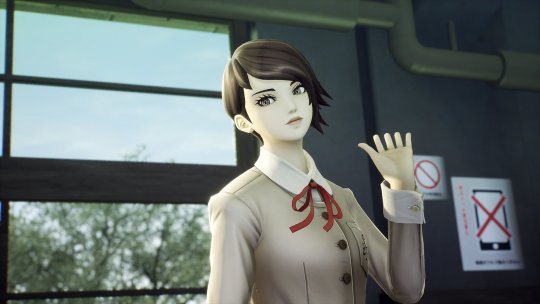
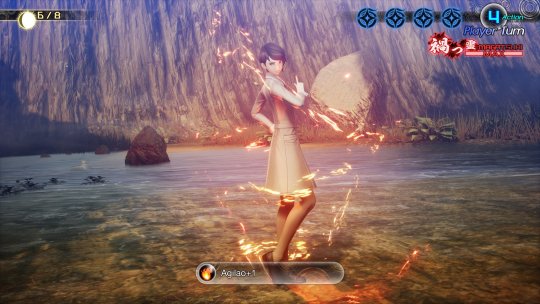
■ Over 270 Demons
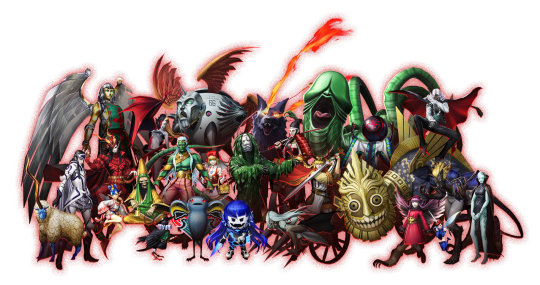
In addition to existing demons, this title features more than 270 demons, including new demons newly drawn by the character designer Masayuki Doi. Enjoy an incredible demon experience!
■ Includes Shin Megami Tensei V Downloadable Content Demons and Quests!
The demons and quests that were available with Shin Megami Tensei V are included in this title as standard features! Experienced players are encouraged to try their hand at these challenging quests.
“A Goddess in Training”
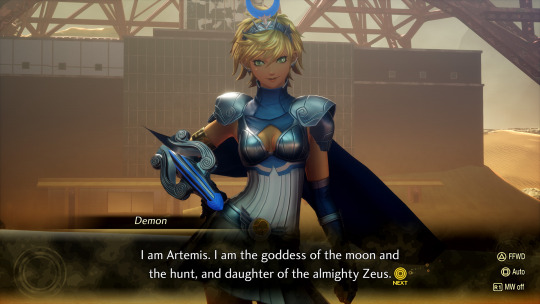
“The Rage of a Queen”
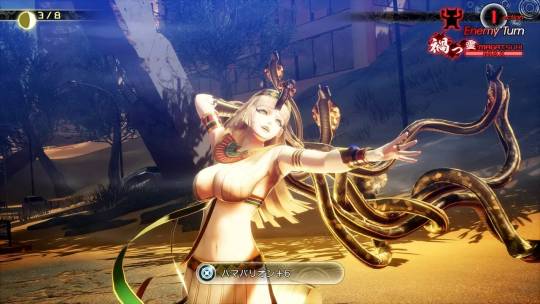
“The Doctor’s Last Wish”
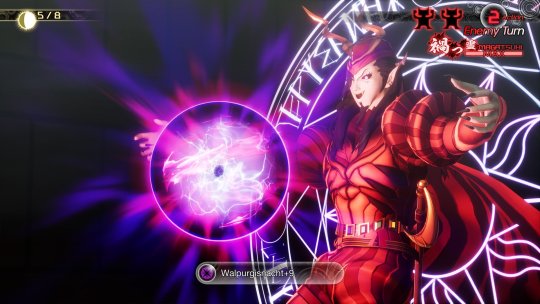
“Return of the True Demon”

■ Evolution in Depth!
Every system of Shin Megami Tensei V has been brushed up in detail and new elements have been added, including field exploration, demon conversations, battles, growth elements, and new demon experiences! Of course, with multiple endings—this is truly the definitive version of Shin Megami Tensei V.
Adding unique skills to all demons, new interactions with demons, and more… Many other new elements! Stay tuned for more information!
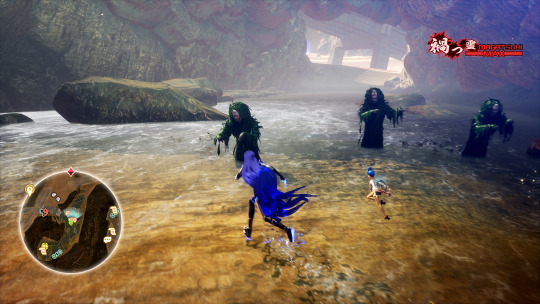
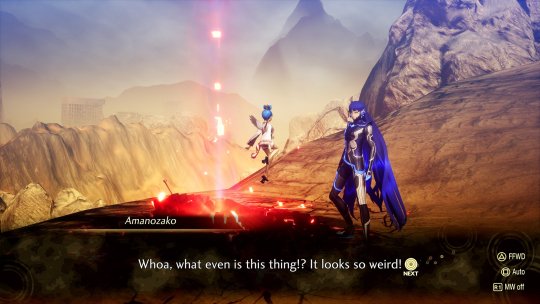

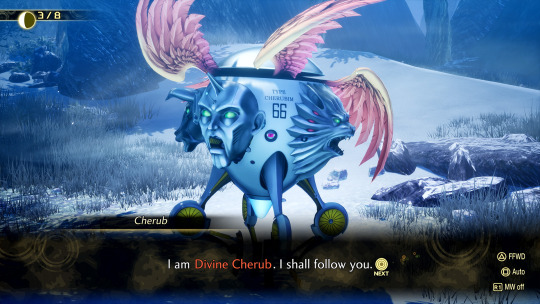

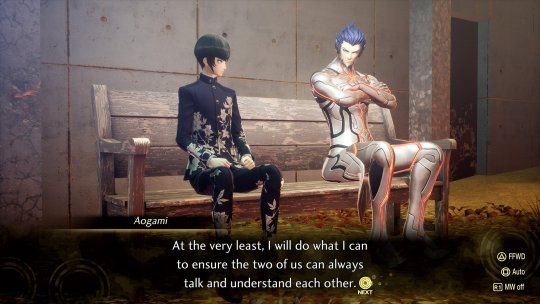

■ Additional Downloadable Content
Downloadable content featuring new demons will be distributed simultaneously on the release date.
Demon God Dagda from Shin Megami Tensei IV: Final and newly introduced is the demon Goddess Konohanasakuya, newly drawn by character designer Masayuki Doi!
Holy Will and Profane Dissent
When the protagonist goes to investigate a mysterious reaction, he meets Danu, the earth mother goddess, who claims to have come from a world that exists in another universe. Danu is apparently searching for his son, Dagda. The protagonist embarks on a search for Dagda with Danu. By completing the game, Dagda can be made an ally, and fusion will be unlocked.

Sakura Cinders of the East
Konohana Sakuya laments the turbulent world and searches for a hero who can pacify the world. She sees an image of a certain hero within the protagonist and challenges him. Winning the battle will allow you to make Konohana Sakuya your ally, and fusion will also be unlocked.
In addition, earning downloadable content that makes it easier to gain experience and in-game currency will be released at the same time.
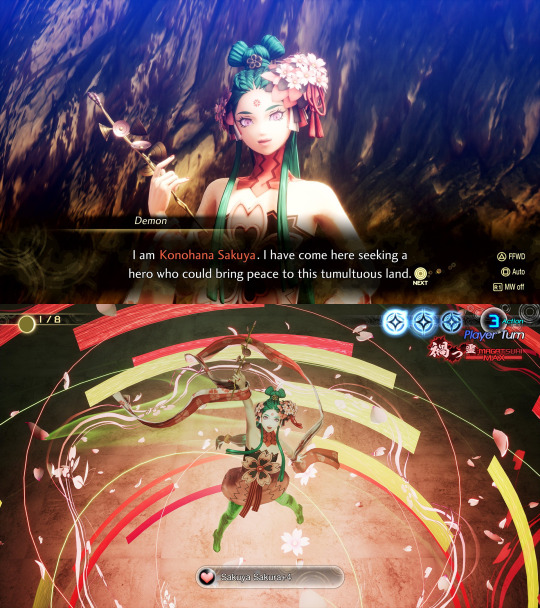
#Shin Megami Tensei V Vengeance#SMTVV#Shin Megami Tensei 5 Vengeance#SMT5V#Shin Megami Tensei V#SMTV#Shin Megami Tensei 5#SMT5#Shin Megami Tensei#SMT#Megaten#Atlus#video game#Nintendo Switch#PlayStation 5#PlayStation 4#Xbox Series#Xbox Series X#Xbox One#PC#Steam#Microsoft Store
101 notes
·
View notes
Text
MIK s2e2: MĀORI CULTURE: Sam recalls some poignant moments when he gets a Māori "moko"

After reading a post about a TV Line recap of MIK episode 202, I decided to watch this episode about Māori culture for myself. I was touched by the scenes where Sam and Graham each tell their stories in the process of getting a nonpermanent version of a "moko" (or tā moko), a deeply meaningful form of tattoo in the Māori culture.

Tā moko artist Hohua Mohi explains that someone who wants a moko will "sit down for a good hour" and start talking about some part of their life that is meaningful, like their family, where they came from, etc. As they are talking, the moko artist is drawing, and consequently, every moko is unique and very personal.

The Story Behind Sam's Moko

SAM: Well my dad left, when I was, uh, very young, three years old, so I didn't--I didn't know him at all.
HOHUA: Yeah.
SAM: I actually didn't know his name.

SAM: And uh, my mum brought me up with my elder brother in the south of Scotland. She's--she's been very, very strong my whole life. And she struggled, I think, to look after two young boys.

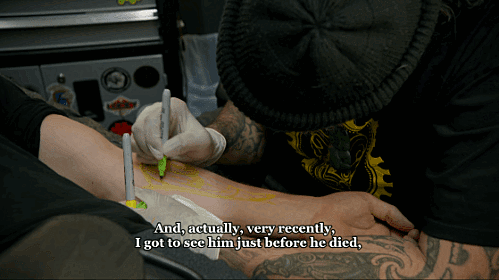
SAM: Um, and it probably wasn't until I was… mid-20s that I finally, uh, met my dad. And, actually, very recently, I got to see him just before he died, which was uh, incredible, just to learn about him and his life.


SAM: And, uh, we spent a few days together.
I work a lot, and I'm very fortunate. But I always put it first. So I guess, uh, relationships are difficult.

Sam's Moko Explained and Revealed


HOHUA: So, if you look at it, it talks about your--your father. It talks about your dad and then your brother in here. This manaia here represents your mum. And so it's obviously facing upwards.
SAM: Yeah.
HOHUA: I've been giving you advice.
SAM: Ah, so she's been giving me advice, mm.
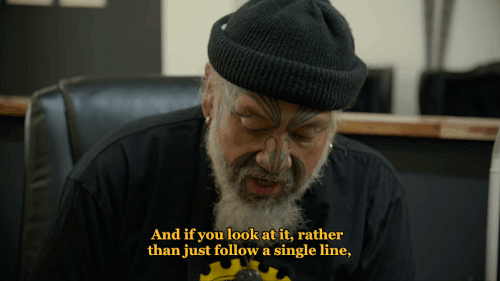
HOHUA: And if you look at it, rather than just follow a single line, all of these colors, they branch off, they branch off, they branch off.
SAM: Yeah, yeah.
HOHUA: And it was-- They came from you talking about how you wanted-- ultimately, you know, you don't know whether or not you're gonna settle down there, but you- you want to go and see the world.
SAM: Somewhere else, yeah, yeah.
HOHUA: So that's what--that's what this will remind you of. You know?
SAM: Different branches.

HOHUA: Yeah, but also, no matter which way you branch off, never forget where... [speaking native language]
SAM: Wow.
HOHUA: Hmm.
SAM: My friend. [shakes hand] So beautiful.
GRAHAM: That is really--
SAM: Thank you so much.
GRAHAM: It's pretty.
SAM: Isn't that awesome?

SAM: A strange experience as well.
GRAHAM: A unique experience.
SAM: Yeah, just also very personal. It felt like going to therapy a little bit.
GRAHAM: Yeah.
SAM: But, uh, very, very honored.
GRAHAM: Yeah. Yeah. Really, thank you so much.

Being a therapist myself, it seemed to me that the process of getting a moko is very much a therapeutic experience. The person getting a moko focuses inwardly and shares important parts of their past that define who they are. The moko artist appears not to be judgmental and listens at a deep level. Then the artist presents the moko, which is a visual symbol of something very unique about the person. And they also give verbal feedback to the person about what they have understood to be the essence of their story.
Sounds like a "therapeutic" encounter to me!
[edited]
___________
NOTE: Images of Sam's moko were enhanced for clarity and to accentuate the colors.
Thanks @thetruthwilloutsworld for making the TV Line Recap post. I'd never watched any episode of MIK before. I'm glad I watched this episode. I enjoyed learning about Māori culture, as well as finding out more about Sam's and Graham's personal backgrounds.
#men in kilts#season 2#episode 202#maori culture#sam heughan#graham mctavish#moko#tā moko#hohua mohi#outlander cast#my gifs#my edits
329 notes
·
View notes
Text

Distinguish yourself through our exceptional design solutions - presentations that eloquently convey their message - Visual Sculptors
#Consulting Presentation#Business Presentation#Graphic Design#Management Consulting Presentation#Pitch Deck Design#Corporate Presentation#Executive Presentation#C-Level Presentation#Business Report Design#Mc-Kinsey Style Presentation#Top-Level Consulting Presentation Designs#Presentation Visual Enhancement#Branding Collaterals Design#Google Slides Design#Keynote Presentations#Webinar Presentation#PowerPoint Presentation Template Designs#Customized Branding Template Creation#Business PPT designs#Consulting Slides Design
2 notes
·
View notes
Text

Here a guide to how to create your own rituals.
There is as always no need to follow all the steps.
Take what feels good for you.
You can modify to your own comfort. This will help you in your journey to have a more peaceful and spiritual lifestyle.
✨✨✨✨✨✨✨✨✨✨✨✨✨✨✨✨✨✨
Create your own easy rituals for personal empowerment and mindfulness:
1. Cleanse:
• Begin by cleansing your space, whether physically or energetically, to create a sacred environment.
2. Candles:
• Light candles to symbolize illumination, focus, and connection with the divine.
3. Essential Oils:
• Incorporate essential oils for their aromatherapeutic properties, enhancing the atmosphere and promoting mindfulness.
4. Smudge:
• Use smudging herbs like sage or palo santo to purify the energy around you.
5. Ground:
• Ground yourself by connecting with the earth, fostering stability and balance.
6. Flowers:
• Include flowers for a touch of nature, symbolizing growth, beauty, and the cycles of life.
7. Crystals:
• Choose crystals that resonate with your intentions; let their energies support your ritual.
8. Herbs:
• Utilize herbs to infuse your space with natural scents and enhance the ritual’s energy.
9. Connect:
• Connect with your spiritual self through practices like tarot cards, tapping into intuitive wisdom.
10. Meditate:
• Incorporate meditation to quiet the mind, fostering a deeper connection with your inner self.
11. Breathe:
• Focus on intentional breathing, using it as a tool to center yourself in the present moment.
12. Manifest:
• Set intentions and manifest your desires through positive affirmations and visualization.
13. Affirm It:
• Affirm your goals and aspirations, reinforcing positive beliefs in your own capabilities.
14. Journal:
• Keep a ritual journal to document your experiences, reflections, and the progress of your personal journey.
15. Visualize: • Visualize your goals and dreams, using the power of imagination to bring them closer to reality.
Crafting your own rituals allows for a personalized and meaningful spiritual practice, tailored to your unique journey.
#witchcraft#dark academia#witchblr#witches#witchy#witch aesthetic#witch#witch community#witchcore#ritual#spiritualgrowth#spiritual awakening#dark aesthetic#whimsical#dark feminine energy#goth aesthetic#dark goddess#wiccan#paganblr#spirituality#wandering witch#whimsy#gothic#goth girl#witch familiar#cats familiar#familiar#love#self love#gratitude
145 notes
·
View notes
Text
Spiritual showers
Turning your shower into a more spiritual experience can be a wonderful way to start or end your day with mindfulness and tranquility.
Here are some ways to make your shower more spiritual:
1. Set an intention: Before stepping into the shower, set a positive intention for your experience. This could be to wash away stress, find clarity, or simply be present in the moment.
2. Use aromatherapy: Incorporate essential oils or scented shower products with calming or spiritually uplifting scents, such as lavender, eucalyptus, or frankincense.
3. Practice mindfulness: Focus on the sensations of the water and the sound of it falling. Be fully present in the moment, letting go of distractions and worries.
4. Meditate: Consider using your shower time for a short meditation. Close your eyes, breathe deeply, and clear your mind as you feel the water cleanse your body and spirit.
5. Visualisation: Visualize the water washing away negative energy or stress, leaving you refreshed and renewed.
6. Affirmations: Recite positive affirmations or mantras while in the shower to promote a sense of inner peace and self-empowerment.
7. Gratitude: Express gratitude for the water, which is essential for life, and for the cleansing and rejuvenating effects of your shower.
8. Gentle movement: Incorporate gentle stretches or movements to promote physical and spiritual well-being while the water flows over you.
9. Sacred symbols: Consider placing meaningful symbols or objects in your bathroom to create a sacred atmosphere.
10. Music or chanting: Play soothing music or chant softly to enhance the spiritual ambiance and promote relaxation.
Remember that the key is to create a personalized experience that resonates with your spiritual beliefs and intentions.
Experiment with these suggestions to find what works best for you and adds a spiritual dimension to your shower routine.
#witchblr#witchcore#witchcraft#witchlife#white witch#beginner witch#witch tips#grimoire#spirituality#book of shadows#water witchcraft
838 notes
·
View notes
Note
Hello, hope you are having a good day/night
I was wondering if you have any advice for making immortal characters?
I'm making one for a story and kinda stuck on a few things

Crafting immortal characters presents a unique set of challenges for writers. Visualizing the personality and lifestyle of someone who has lived for centuries can be a daunting task. I personally haven't written many immortal characters, but here is my simple guide to writing immortal characters.
Understanding Immortality
Immortality is a concept that has captivated storytellers for centuries. Before diving into the intricacies of writing immortal characters, it's crucial to establish a clear understanding of what immortality means in your story's context. Consider whether your characters are ageless, impervious to injury, or possess an endless lifespan. This foundational knowledge will shape how you approach their characterization and the challenges they might face.
The Appeal of Immortality
Deciding whether to make a character immortal is a significant creative choice. Immortality can add depth and intrigue to a character, but it's essential to weigh the storytelling benefits against potential drawbacks. Consider the thematic elements of your narrative—does immortality serve the central themes of your story? If your story explores the passage of time, loss, or the human condition, immortality can be a compelling tool.
Additionally, immortality allows for the exploration of different time periods, historical events, and changing societal norms. It can provide a unique perspective on human existence and create opportunities for character growth over an extended timeline. However, it's crucial to strike a balance, ensuring that immortality enhances the narrative rather than overshadowing it.
Types of Immortality
When delving into the concept of immortality, it's important to explore the various types that can shape the nature of your immortal character. Immortality isn't a one-size-fits-all concept, and different narratives employ diverse approaches to convey this enduring existence. Here are several types of immortality to consider:
Biological Immortality:
Biological immortality refers to a character's ability to cease aging and remain in a perpetual state of physical youth. This form of immortality doesn't prevent death from external factors like injury or disease but ensures the character won't die from old age.
Regenerative Immortality:
Characters with regenerative immortality possess the ability to recover rapidly from injuries, regardless of their severity. This type of immortality allows for survival in situations that would be fatal to others.
Resurrection Immortality:
Resurrection immortality involves characters who can come back to life after death. This form of immortality often comes with certain conditions or limitations, such as a specific time frame for resurrection or the need for an external force.
Cursed Immortality:
Some immortals might be cursed to live forever as a consequence of their actions or a supernatural event. This form of immortality can add complexity to a character's journey, as they grapple with the burden of eternal life.
Spiritual Immortality:
Spiritual immortality separates the character's consciousness from their physical body. Even if their body is destroyed, their consciousness persists, potentially allowing them to inhabit new vessels or even exist as ethereal entities.
Conditional Immortality:
Characters with conditional immortality can only be killed under specific circumstances or by specific means. This form of immortality often adds tension to the narrative, as characters may need to discover and exploit these weaknesses.
Choosing the type of immortality for your character depends on the themes and dynamics you want to explore in your story. Each type brings its own set of challenges and opportunities for character development.
The Challenges of Writing Immortal Protagonists
Crafting an immortal protagonist comes with its own set of challenges, demanding careful consideration to avoid narrative pitfalls. While the allure of an eternal character might be tempting, it's essential to navigate potential obstacles effectively. Here are some challenges you might encounter when writing immortal protagonists:
Stagnation and Boredom:
Immortality could lead to stagnation, with characters becoming disinterested or bored over centuries. Finding meaningful pursuits or addressing existential ennui becomes a crucial aspect of immortal character development.
Loss and Grief:
Immortal characters often witness the passing of loved ones, raising questions about coping with eternal grief. Exploring the emotional toll of enduring relationships and inevitable farewells adds depth to their narrative.
Maintaining Tension:
The fear of death is a powerful narrative tool, and writing an immortal character requires innovative ways to sustain tension. Introducing other forms of vulnerability or consequences for their actions becomes essential to keep the stakes high.
Relatability to Mortals:
Immortal characters might struggle to relate to mortal experiences, making it challenging for readers to empathize. Balancing their extraordinary existence with relatable elements ensures readers can connect with the character on a human level.
Memory Overload:
With centuries of experiences, memory overload is a realistic concern. Immortal characters may grapple with the weight of accumulated memories, potentially leading to mental strain or identity crises.
Moral Evolution:
Immortal characters must undergo moral and emotional evolution over time. Addressing how their perspectives change across centuries and adapting to evolving societal norms adds complexity to their character arc.
Navigating these challenges requires a delicate blend of creativity and empathy. Immortal protagonists offer unique storytelling opportunities, but their narratives demand careful handling to resonate with readers and maintain a compelling plot.
Character Development and Immortality
Creating a dynamic and relatable immortal character hinges on their growth and transformation over time. While immortality offers longevity, it shouldn't equate to static personalities. Consider the following aspects to ensure your immortal protagonist undergoes meaningful character development:
Learning from Experiences:
Immortality grants the opportunity for characters to accumulate diverse experiences. Showcase how these encounters shape their beliefs, values, and perspectives. Immortal characters should evolve emotionally and intellectually, drawing wisdom from their extensive life.
Adapting to Change:
Explore how your immortal character adapts to societal and technological changes. Their ability to navigate evolving landscapes, both physically and metaphorically, provides opportunities for character development and engaging storytelling.
Embracing Vulnerability:
Despite immortality, vulnerability adds depth to characters. Introduce challenges or weaknesses that resonate with readers, fostering empathy and connection. Immortal characters should grapple with their humanity, despite their extended lifespans.
Exploring Relationships:
Immortal characters can form unique connections across different time periods. Delve into the complexities of their relationships with mortals and fellow immortals. Address the impact of enduring friendships, love, and loss on their emotional landscape.
Personal Growth Arcs:
Craft personal growth arcs that transcend centuries. Immortal characters should confront internal conflicts, flaws, and insecurities, showcasing a relatable journey of self-discovery despite their extraordinary lifespan.
Facing Consequences:
Immortality doesn't exempt characters from facing consequences. Establish a sense of accountability for their actions, ensuring that decisions made centuries ago still reverberate in their present. Consequences provide narrative tension and drive character development.
Remember, immortality shouldn't hinder character growth; rather, it should enhance the depth and complexity of their journey. Immortal protagonists can offer readers a compelling exploration of humanity, time, and the enduring quest for self-discovery.
Physical Changes and Lack Thereof
When crafting immortal characters, the portrayal of physical aspects becomes a crucial element. Consider the following factors to effectively convey the unique nature of immortality in your writing:
Ageless Appearance:
Immortal characters often maintain a youthful or ageless appearance, defying the natural aging process. Describe their timeless beauty or the perpetual state of their physical prime, emphasizing the contrast with mortal characters.
Scars and Battle Marks:
Showcase battle scars and marks as enduring symbols of an immortal's longevity. These physical remnants tell stories of epic encounters, providing a visual narrative of the character's journey through time.
Adaptive Evolution:
Explore the idea of adaptive evolution in immortal beings. Depending on your world-building, immortals might possess the ability to adapt physically over time, gaining new attributes or even altering their physical form in response to challenges.
Stasis and Stagnation:
Delve into the potential downsides of immortality, such as the risk of stagnation. Immortal characters might experience periods of stasis, where their physical appearance and abilities plateau, presenting a unique challenge to their personal growth.
Temporal Reflections:
Use reflections, whether in mirrors or bodies of water, to emphasize the temporal disparity between immortals and mortals. Immortal characters may see reflections that carry the weight of centuries, offering poignant moments of self-reflection.
Symbolic Transformations:
Employ symbolic physical transformations to mirror an immortal's internal evolution. For instance, a character's eyes could change color or exhibit unique features during pivotal moments, signaling shifts in their emotional or psychological state.
Effectively portraying physical changes, or the lack thereof, allows readers to immerse themselves in the intricacies of your immortal characters. Balancing the timeless allure with nuanced details enhances the richness of their existence within your narrative.
Psychological Realities of Immortality
Navigating the psychological landscape of immortal characters adds depth and complexity to your storytelling. Consider the following aspects to capture the essence of their enduring minds:
Temporal Perspective:
Immortals view time through a vastly different lens, witnessing the ebb and flow of history. Delve into their temporal perspective, exploring how centuries of existence shape their perception of fleeting mortal lives.
Accumulated Wisdom:
Immortality often comes with accumulated knowledge and wisdom. Showcase the breadth of their insights, portraying them as repositories of experiences and lessons learned throughout the ages.
Isolation and Relationships:
Explore the theme of isolation that can accompany immortality. Immortal characters might struggle with forming lasting connections with mortals due to the inevitable heartbreak of witnessing their transient lives.
Personal Evolution:
Detail the personal evolution of immortal characters over time. Just as their physical forms may change, their personalities and beliefs can undergo profound transformations, allowing readers to witness the intricate interplay of experience and growth.
Existential Questions:
Immortals grapple with existential questions about the meaning of their eternal existence. Address their struggles with purpose and identity, weaving a narrative that reflects the timeless quest for self-discovery.
Emotional Resilience:
Immortals may develop emotional resilience, adapting to loss and upheaval with a perspective that transcends the immediate pain. Explore how they cope with emotional challenges and form coping mechanisms unique to their enduring nature.
Moral Dilemmas:
Immortality often raises moral dilemmas. Consider how an immortal character confronts questions of ethics, morality, and the consequences of actions that reverberate across centuries.
Crafting the psychological realities of immortality invites readers to delve into the intricate minds of your characters. By seamlessly integrating these aspects into your narrative, you create a compelling exploration of the human—or rather, immortal—experience.
Physical Manifestations of Immortality
The physical aspects of immortal characters can significantly shape their presence in your story. Paying attention to these details enhances the believability of their immortal nature:
Ageless Appearance:
Immortals often maintain a perpetual youthful appearance. Describe how they defy the aging process, showcasing flawless skin, unchanged features, and an eternal vibrancy that sets them apart from mortals.
Healing Abilities:
Explore the regenerative capabilities that come with immortality. Immortal characters can heal from injuries that would be fatal to mortals, adding an element of resilience and invincibility to their physicality.
Resilience to Disease:
Immortality typically grants immunity to diseases and ailments. Consider how your characters navigate a world where mortal afflictions hold no power over them, emphasizing the contrast between their enduring health and the vulnerabilities of mortals.
Enhanced Strength and Agility:
Immortals often possess heightened physical abilities. Showcase their extraordinary strength, agility, and reflexes, allowing them to excel in physical feats beyond the capabilities of ordinary humans.
Immortal Scars and Markings:
Delve into the concept of immortal scars—wounds that may linger as reminders of past battles or significant events. These scars, unlike mortal wounds, serve as enduring symbols of an immortal's journey through time.
Adaptation to Environment:
Consider how immortals adapt to various environments and climates. Whether it's extreme temperatures or challenging terrains, their bodies may possess a remarkable ability to endure conditions that would challenge mortal limits.
Shape-Shifting or Transformation:
Some immortals possess the ability to change their physical form. Explore the concept of shape-shifting or transformation, allowing your characters to adopt different appearances throughout their eternal existence.
Inherent Magical Traits:
Immortality is often intertwined with magical elements. Highlight any inherent magical traits your characters may possess, such as the ability to manipulate elements, control forces of nature, or tap into mystical energies.
By intricately weaving these physical manifestations into your narrative, you create a vivid portrayal of immortal characters that captivates readers and adds a layer of enchantment to your storytelling.
I hope this blog on How To Write Immortal Characters will help you in your writing journey. Be sure to comment any tips of your own to help your fellow authors prosper, and follow my blog for new blog updates every Monday and Thursday.
Looking For More Writing Tips And Tricks?
Are you an author looking for writing tips and tricks to better your manuscript? Or do you want to learn about how to get a literary agent, get published and properly market your book? Consider checking out the rest of Haya’s book blog where I post writing and publishing tips for authors every Monday and Thursday! And don’t forget to head over to my TikTok and Instagram profiles @hayatheauthor to learn more about my WIP and writing journey!
#hayatheauthor#haya's book blog#haya sameer#haya blogs#writers on tumblr#writer community#writer tools#writer blog#writer stuff#writer wednesday#writer tips#creative writing#writers of tumblr#writerscommunity#writeblr#writing community#writer spotlight#writer things#writing prompt#writing tools#writing stuff#writing#writing life#writing inspo#writing help#writing advice#writing inspiration#writing ideas#writing things#writing tip
130 notes
·
View notes
Text
good things about ep. 7:
this episode was by far the best at working with film as a medium. there were still issues, to be mentioned soon, but this ep did a lot of things that impressed me on a level of cinematic structure and format:
some actual tension!! simply showing the trio running from cerberus created investment and stakes for me in a way no monster fight or other obstacle had before (a matter definitely enhanced by the music)
the use of flashbacks!! now, i have some issues with the content of those flashbacks, but since im basically getting two degrees in assessing media i know how to give credit where credit is due lmao. these flashbacks were doing interesting things cinematically, creating parallels with percy's experiences in the present, especially that last flashback where they continued poseidon's voiceover into the present moment. fuck yes!! use the medium of cinema to your ADVANTAGE!!
related to the use of flashbacks, the match cuts!! they were so good, as they helped make visual those narrative and characterological parallels being constructed through the flashbacks. film is an inherently visual and auditory medium, and it was so refreshing to see the show experimenting and making effective choices with those tools
some issues with ep. 7 and the series as a whole:
i'll admit it. im tired of the trio already knowing everything about every obstacle they face (having to improvise in the fight with cerberus was so refreshing and retained more of the spirit of the book as opposed to uh. every other obstacle). and i think this connects with show's overall struggle with writing, adaptation, and the medium of film. these writers have committed the cardinal sin of assuming their audience always needs explanation. in any writing class (fiction and screenwriting are my personal expertise), you are told to assume your audience is smarter than you think, bc a writer's instinct is to assume they need to be clear about action and themes out of a fear of confusing their audience and the end result of that situation is a boring, overly explanatory piece of work. (an re the young viewers, kids are freaking smart!! i literally teach kids of the age range these books are directed for and they are so quick-witted. kids don't need stuff handed to them on a platter, they know how to put puzzle pieces together.)
example of the aforementioned "too much knowledge" issue: the pearls. (people have already explained the issues with medusa, the casino, procrustes, etc., so im going for a new one that's been bugging me a bit.) after percy received four pearls, the general conclusion people came to was that one pearl would break, forcing them to have to choose three people to go/one to stay and thus making the choice more "meaningful" (i.e. bc the opportunity to save everyone had been stripped). it's a fair choice, a fair reason, a fair analysis, and this is a change that bothers me but much more minimally than other changes to the show. here's the deal: the reason they had to give four pearls in the show was bc the trio already knew exactly what the pearls would do. there was no reason to give only three pearls bc that would force a character (probably percy) to raise the question of like "hey, that's not enough to save four people!" so where am i going with this?
in the books and the musical, we get the alluring line of what belongs to the sea can always return to the sea. percy gets three pearls in the book and a seashell in the musical, where he doesn't know right away the specifics of what this gift does (the seashell is an excellent example of adapting a story to a new medium, as a low-budget theatrical production can't afford the effects of smashing three pearls and causing people to vanish from the stage, so blowing the seashell to open a portal was a great move that worked for the new medium and retained the spirit of the source material - percy having an epiphany well after receiving the gift about what, exactly, the gift did and how it would help him). in the show, they issue is that they already know, thus creating the dilemma of there being no reason not to give four pearls. again, not the worst choice the show has made, but it's another example of how the show's most pervasive issue is over-explaining and giving too much information to its characters.
in short: the pjo show doesn't understand "show don't tell." they love telling even though "showing" is Most Important in film as a medium, like it's even more important to show what's going on in film than it is in prose because cinema is an inherently collaborative medium that generates a visually-dominated product. the show clearly lacks a fundamental understanding of the medium it is working with!! and that is bad!!
another issue: the lighting. this show suffers from the current trend in film to make dark scenes impossible to see in.
more characterological problems: the gods are not imposing. just to speak of ep. 7 alone, why was hades so... banter-y? in the book he literally makes percy's hand "move... against [his] will" to show him the pearls. there was none of that power and domineering energy in the show!! the pjo show keeps hammering us over the head with what should be a series-long revelation about the gods' flaws and pettiness and spite and misuse of their incredible power, and yet all of the gods seem almost like... caricatures. where is their ability to be charismatic and threatening. to be lax and powerful. to remind us that they can, have, and will kill demigods.
core thematic issue: the show lacks the humor and fun and adolescent spirit of the books. i've seen a lot of people insist the show is directed for young readers of the book, which i don't disagree with, but the lack of humor and energy and vitality is undoubtedly turning off a lot of younger viewers. in a lot of instances, everything feels so gritty and angsty, lowkey like the winx adaptation (but on a less severe scale). we have moments of sass/sarcasm, moments of levity, but it doesn't feel like a core trait of the show (much less of percy) like it does in the book. and honestly, i think that's a loss! if rick wanted a grim pjo adaptation, fine, but i wish the show hadn't been advertised as something perfectly attuned to the spirit of the book bc it's just not. if it was, i'd be laughing a lot more.
now, let's talk about sally...
i don't love how they've characterized sally in this show. i respect that they wanted to "modernize" her character and more accurately demonstrate the struggles of a single parent raising a child with learning (and in percy's case, also magical) difficulties. i genuinely do respect that choice, and i can follow the thorough-lines created in the show that illustrate this revamping of her character. similarly, i can respect that they didn't want sally to seem like a stereotypical "passive" victim of abuse re gabe, hence her explicitly pushing back at him. that said...
i still don't think these are effective or necessary changes, because i don't think sally was portrayed as overly passive or as a perfectly equipped parent in the book. i understand the argument that gabe is still presented as abusive, i.e. that he checks her phone without permission and controls access to the car, but those moments feel so technical. when i rewatch those scenes and examine the acting (both line delivery and bodily cues), sally is outwardly derisive toward gabe ("who's yancy?" / sally sighs and shakes her head, exasperated, has the long blink to give an extra beat before responding: "the school."), yet at the same time there's a banter between them, where sally insists that she's going to go to montauk no matter what, and if gabe disagrees then she won't bring back both their sandwiches for the knicks game that they apparently watch together often (implied by "you know i hate watching the knicks alone!" "so do i!"). sally holds herself confidently in this scene (hands on her hips). gabe is forced to actually ask politely for his sandwich order (and notably holds his shoulders slightly inward, visually closing himself off in a physical representation of surrender). two of my friends, diehard pjo fans who are not literature or film scholars, were both confused as to why sally and gabe seemed to be bantering within a seemingly standard relationship dynamic - not necessarily the happiest of couples, but a standard married couple (as opposed to clear imbalance of power between them in the book).
to be clear, it's not that sally needs to be a "passive victim of abuse," and it's certainly not that the show needs to explicitly depict gabe hitting sally or percy for us to understand that he is abusive. my issue is that the show seems to have not understood what made sally a strong character initially: her willingness to endure anything for her son, including marrying an abusive man who smelled so rankly human in order to prevent monsters from finding them. like, sally resisted gabe's abuse in the book! the reason blue food is a major motif in the first place is because sally and gabe had a fight where gabe insisted blue food wasn't a thing, and thus percy observes that "ever since, my mom went out of her way to eat blue."
in other words, verbally standing up to one's abuser is not the only way to demonstrate that a character is not a stereotypically weak, helpless, passive victim. it's definitely an easy choice with regard to cinematic staging (and the show has a pattern of taking the easy way out of conflicts and nuance), but i think the real issue is that sally's vocal protests come in tandem with the defanging of gabe. why does his body language and tone falter in arguments with sally? does he not have the upper hand? where is the evidence of an imbalanced power dynamic? there is no one way to write abuse bc the tragic reality is that abuse happens in an infinite number of ways, but nonetheless i am frustrated with the route the show went down in the first ep bc it feels reductive to the core of sally's character and her strengths: her endurance, her implicit but present rebelliousness, and her love for her son.
im also not a fan of some of the flashbacks we're getting with sally. it's not that sally shouldn't be "allowed" to get frustrated ever, but a major element of her characterization in the books is that she didn't take that frustration out on percy. i just don't see sally jackson getting upset that percy doesn't want to swim (beside that, i can't imagine percy not wanting to swim lmao). i just don't see sally jackson almost aggressively telling percy that he is the one making their goodbye ugly (because he's being a kid?? who doesn't want to leave his mom?? you're telling me sally wouldn't recognize the root of his anxiety immediately??). i just don't see sally speaking vaguely to percy about there being things she has to do that he doesn't understand instead of doing her best to meet percy where he's at with her explanation. if someone is coming to this show without having read the books, i genuinely think they might be starting to question sally's parenting, i.e. if she was really as wonderful a mom as percy insists or if he simply sees her through rose-tinted glasses. bc here's the thing: percy does see sally and his mom's struggles through rose-tinted glasses, and it's because sally bottles up and hides her struggles and frustrations from him. she doesn't let percy witness those frustrations. as such, there's an incongruity between book!sally and show!sally that doesn't mesh for me.
in short, show!sally feels like a new character to me. that's fine if that's the route they wanted to take, but again: why advertise it as a faithful adaptation if you're not going to be faithful to the core elements of central characters?
im also disappointed by how much the show has stripped annabeth of her character besides her intelligence. i have some thoughts about the adultification of young Black girls and the fact that annabeth is Black in the pjo show, mostly that i can't tell yet whether the show has the self-awareness to offer commentary on this reality for many Black girls through annabeth's character being seemingly defined by her intelligence and maturity or if they're simply unwittingly replicating this circumstance. i need more material before i can make a concrete assessment here, but all the same, i wish they were allowing these kids and especially annabeth to be kids - to make mistakes, to fall into traps, to have little crushes and get flustered, and to not know everything about every monster/obstacle before they come to face it.
people have talked to death the issue of the pacing so i won't belabor it but in general this show has terrible pacing. the first two eps are rushed (we got so little luke that im concerned his betrayal won't have much heart/meaning/oomph in the final ep), the constant unnecessary exposition creates periods of narrative drudgery, most of the fights lack tension bc the choreography is effectively nonexistent, them missing the solstice deadline has so far sucked the wind of the energy of their quest (of which there wasn't much in the first place bc the show did a poor job establishing the looming threat of a globally destructive war being on the horizon), and in general there's no sense of stakes. sigh.
i probably have more thoughts, but i'll stop for now bc i've got a shit ton of assignments to work on. in sum: the show lacks an understanding of how film operates as a medium, and while the merit of the show as an adaptation can be debated, it's simply a poorly constructed and lackluster piece of tv.
(but on the bright side? the trio is killing it even with the weak material they've been given, and their acting talent is the only reason i and many of my friends have kept watching)
#pjo show crit#pjo tv crit#my brain is EXPLODING with thoughts lmao#now i've gotta go work on my own movie o7 godspeed everyone#amy analyzes
99 notes
·
View notes
Text
3 Ways to Plant Ideas into the Subconscious
🌹 ✦•······················• 🖤
Planting Ideas into the Subconscious Mind is powerful and can be used on yourself and on others to manifest your desires.
When it comes to getting your way in disagreements, it is always easier to insinuate what you want rather then nag or fuss about it. If you want something, never ask, Insinuate.
Insinuation means to hint at or suggest something in a subtle, sly way.
You may notice during a disagreement that when you directly ask a person to do something they turn defensive. This is because no one likes to be told what to do or like being nagged. (And honestly it's annoying). People like to feel independent and in control of the choices that they make.
By using insinuation, it makes the person believe it is their idea. This motivates them to act on their own will, or so they think. It works like a charm. This as an easier way to communicate and build bonds with other people.
Whether it’s your own subconscious or someone else’s, planting ideas in the subconscious requires strategic thought and proper planning.
1. Stay Calm
Remember insinuation means to hint at or suggest something in a subtle, sly way.
This method works more so when you're planting ideas into another persons subconscious. It is easier to resolve a problem or an argument through calmness than it is through pleading with someone or using an accusing tone.
When you address someone directly and aggressively they will respond defensively and will become less motivated to change their behavior.
But by staying calm, especially during a disagreement, it makes the other person drop their guard and listen to your POV.
2. Use Suggestive Language
Here are some examples of using suggestive language.
(In a relationship)
"You need to take the trash out! It's full!” → “I love a man who takes the trash out. It shows that he's such a gentleman which is honestly so attractive.”
"You're showing too much! You look trashy! → "I love seeing you in the black dress. It looks so classy on you."
"It's your turn to wash the dishes! This kitchen looks awful!" → "Whenever I go to my friends house her kitchen is so clean. Her man helps her clean up. I just love when a man helps out around the house. She really got lucky."
Swap the accusive language and use suggestive language.
Using suggestive language is not always easy and requires you to think and stay calm in heated moments. But in the end it works better than exhausting yourself and playing the role of the mom - the nagger.
It's best when you mention things like this randomly and then change the subject to allow what you said to sit in the other persons mind and register subconsciously.
Tips:
Compliment a habit of someone else that you'd like your person to have or want them to do
Don't ask blatantly
Don't use 'YOU' statements
Use 'I' statements
Don’t blame
Talk of your displeasure but never of the other persons flaws since this puts them on defense.
3. Surroundings
This method is more effective when it comes to planting thoughts into your own subconscious mind.
It is important to surround yourself with things that remind you of what you wish to have. Whether that's a new mindset, lifestyle, etc.
Use Repetition:
Create affirmations and repeat them daily.
Watch subliminals.
Write manifestations in present tense as if you already have them.
Visualize yourself as already having what you desire.
Take classes to enhance your skills.
Watch others and mimic them.
Mirror powerful body language.
#succulentsiren#writers and poets#subconscious#subliminals#divine feminine#subconscious mind#dark feminine energy#affirmations#confidence#relationship#it girl#siren#dark femme#femme fatale#dark femininity#femininity
131 notes
·
View notes